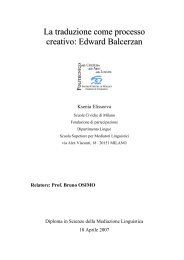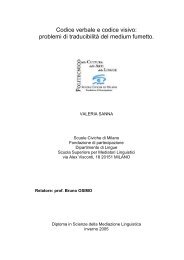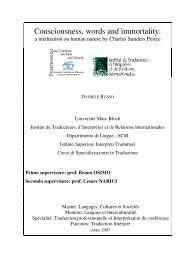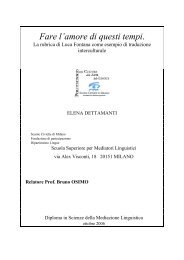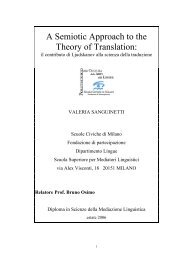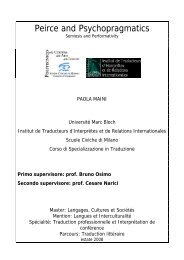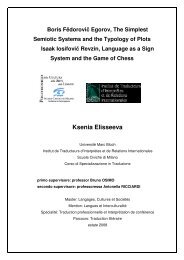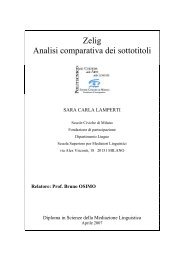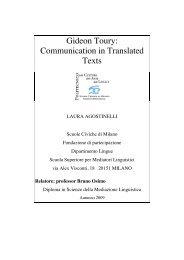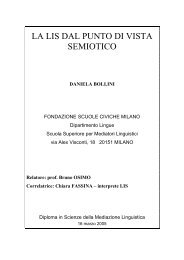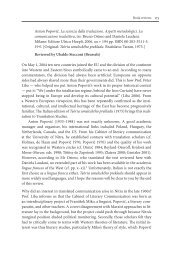Alice in Wonderland - Bruno Osimo, traduzioni, semiotica della ...
Alice in Wonderland - Bruno Osimo, traduzioni, semiotica della ...
Alice in Wonderland - Bruno Osimo, traduzioni, semiotica della ...
Create successful ePaper yourself
Turn your PDF publications into a flip-book with our unique Google optimized e-Paper software.
pozzo di melassa: «‘[...] did you ever see such a th<strong>in</strong>g as a draw<strong>in</strong>g of a<br />
muchness?’» (Carroll 2002:68). La parola «muchness» viene usata <strong>in</strong><br />
<strong>in</strong>glese esclusivamente nell’espressione «it is much of a muchness», che<br />
“equivale” all’italiano «se non è zuppa è pan bagnato» (Carroll 1993:128).<br />
Da qui la difficoltà di <strong>Alice</strong> a immag<strong>in</strong>are un disegno che raffiguri un simile<br />
“oggetto”, trattandosi non semplicemente di un concetto astratto ma di una<br />
parola usata solo <strong>in</strong> un’espressione idiomatica. Ci sono poi rimandi<br />
probabilmente più difficili da cogliere, come nel caso «the Duchess was very<br />
ugly» (Carroll 2002:81). Qui l’autore fa riferimento a un dip<strong>in</strong>to, risalente al<br />
C<strong>in</strong>quecento, del pittore fiamm<strong>in</strong>go Quent<strong>in</strong> Matsys. Ciò che fa pensare al<br />
riferimento è <strong>in</strong> primo luogo l’enfasi posta sulla parola «very» per mezzo del<br />
corsivo. Sembra <strong>in</strong>fatti che Carroll dia per scontato che la Duchessa debba<br />
essere brutta, commentando semplicemente che <strong>in</strong> effetti è «molto» brutta.<br />
Se andiamo a vedere il ritratto, ne scopriremo un’<strong>in</strong>credibile somiglianza<br />
con l’illustrazione di Tenniel che raffigura il personaggio <strong>della</strong> Duchessa di<br />
<strong>Alice</strong> <strong>in</strong> <strong>Wonderland</strong>.<br />
5. Giochi di parole basati sui pronomi<br />
Una particolare categoria di giochi di parole <strong>in</strong> cui ci si imbatte leggendo<br />
<strong>Alice</strong> <strong>in</strong> <strong>Wonderland</strong> è quella che si basa sulle particelle pronom<strong>in</strong>ali,<br />
particolarmente favorita dalla struttura <strong>della</strong> l<strong>in</strong>gua <strong>in</strong>glese, che fa un uso<br />
molto più abbondante dei pronomi rispetto all’italiano. Tali particelle sono<br />
spesso polivalenti, ovvero possono avere valore e significato diverso a<br />
seconda <strong>della</strong> frase <strong>in</strong> cui sono <strong>in</strong>serite. È questo il meccanismo che fa<br />
funzionare certi giochi di parole presenti <strong>in</strong> <strong>Alice</strong> <strong>in</strong> <strong>Wonderland</strong>.<br />
‘What do you mean by that?’ said the Caterpillar sternly. ‘Expla<strong>in</strong><br />
yourself!’<br />
‘I can’t expla<strong>in</strong> myself, I’m afraid, sir’ said <strong>Alice</strong>, ‘because I’m not<br />
myself, you see.’ (Carroll 2002:40)<br />
Questo pun, per esempio, funziona grazie alla polivalenza del pronome<br />
«myself», qui usato sia per rendere il significato di «spiegarsi» che di<br />
«spiegare sé stessi». <strong>Alice</strong> è conv<strong>in</strong>ta di non essere più sé stessa dopo tutte<br />
18



